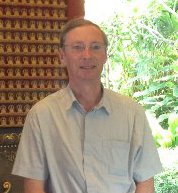We are pleased to present a selection of our authors of the May issue of NJC. We thank each of them for accepting our invitation and having kindly taken some of their time to answer a few questions for us.
 Our first author is Oana R. Luca who is a Graduate Student at Yale University (USA) in the group of Prof. Robert H. Crabtree. Her current research interests are mainly focused on electrocatalysis, more specifically the production and storage of H2. In her NJC paper, Oana and co-workers report on a Ni(II) complex with a redox-active pincer ligand which reduces protons effectively at a low overpotential in aqueous acidic conditions. A combined experimental and computational study provides mechanistic insights into an unusual putative catalytic cycle.
Our first author is Oana R. Luca who is a Graduate Student at Yale University (USA) in the group of Prof. Robert H. Crabtree. Her current research interests are mainly focused on electrocatalysis, more specifically the production and storage of H2. In her NJC paper, Oana and co-workers report on a Ni(II) complex with a redox-active pincer ligand which reduces protons effectively at a low overpotential in aqueous acidic conditions. A combined experimental and computational study provides mechanistic insights into an unusual putative catalytic cycle.
When asked what led to the publication of this article at NJC, Oana responds: “NJC is a forum for cutting-edge work in the chemical sciences”.
Out of the lab, Oana enjoys spending time with her friends, playing chess, reading and playing guitar. If Oana could not be a scientist, she would probably be a baker.
A tridentate Nickel pincer for aqueous electrocatalytic hydrogen production by Oana R. Luca, Steven J. Konezny, James D. Blakemore, Dominic M. Colosi, Shubhro Saha, Gary W. Brudvig, Victor S. Batista and Robert H. Crabtree, New J. Chem., 2012, 36, 1149-1152; DOI: 10.1039/C2NJ20912H.
Our next author is Mariano Venanzi, Associate Professor of Physical Chemistry at the University of Rome Tor Vergata (Italy). Mariano’s research interests focus on biotechnology, peptide materials and spectroscopy of biological molecules.
In this issue of NJC, Mariano has authored the article Glucosylated steroid-porphyrins as new tools for nanotechnology applications by R. Lettieri, D. Monti, Karel Zelenka, Tomáš Trnka, Pavel Drašar and M. Venanzi, New J. Chem., 2012, 36, 1246-1254; DOI: 10.1039/C2NJ20982A. “Porphyrins are versatile scaffolds that can be suitably engineered for applications in different environments. The paper shows how the unique self-assembly properties of derivatized porphyrins can be exploited for forming complex supramolecular structures (mesoscopic aggregates, multilayer films, inclusion complexes in liposomes)”, explains Mariano who chooses NJC for publication of this article as “NJC is an authoritative journal edited by a prominent chemical society with a large readership”.
In his free time, Mariano loves spending time running, trekking and listening to music. If Mariano was not a scientist, he would have been a historian or a mystery fiction author.
 Mark Moloney is Professor of Chemistry at the University of Oxford (UK).
Mark Moloney is Professor of Chemistry at the University of Oxford (UK).
His current research interest is synthetic organic chemistry in the areas of natural products, drug development and surface science.
In this NJC issue’s paper, Mark and co-workers describes the culmination of a large multidisciplinary project to demonstrate that the surface modification of materials can be used to control protein binding, and that this behaviour can be correlated with surface chemistry and with modern cheminformatic descriptors more normally used in the drug discovery process.
Post-Polymerisation Modification of Surface Chemical Functionality and its Effect on Protein Binding by Cleo Choong, J. S. Foord, Jon-Paul Griffiths, Emily M. Parker, Luo Baiwen, Meghali Bora and Mark G. Moloney, New J. Chem., 2012, 36, 1187-1200; DOI: 10.1039/C2NJ00002D.
“NJC was chosen as a highly attractive home for this work because of its wide readership and the fact that it encourages genuinely interdisciplinary work.”
Walking, swimming and gardening are Mark’s favourite activities. If he could not be a scientist, Mark would love to run a small-holding specialising in rare animal breeds.
Closing this month’s author selection, Yuxin Zhao is PhD student at the Griffith University (A ustralia).
ustralia).
His current research interest are metal-based nanomaterials, carbon-based nanocomposites and dye-sensitized solar cells. He has authored in this NJC issue the paper A Flexible Chemical Vapor Deposition Method to Synthesize Copper@Carbon Core-shell Structured Nanowires and Study of Their Structural Electrical Properties by Yuxin Zhao, Juan Wang, Ying Zhang, Yanpeng Li and Zifeng Yan, New J. Chem., 2012, 36, 1255-1264; DOI: 10.1039/C2NJ40036G.
Out of the lab, Yuxin’s favorite activity is Chinese traditional painting and if he was not a scientist, he would be an artist in oriental traditional painting.










